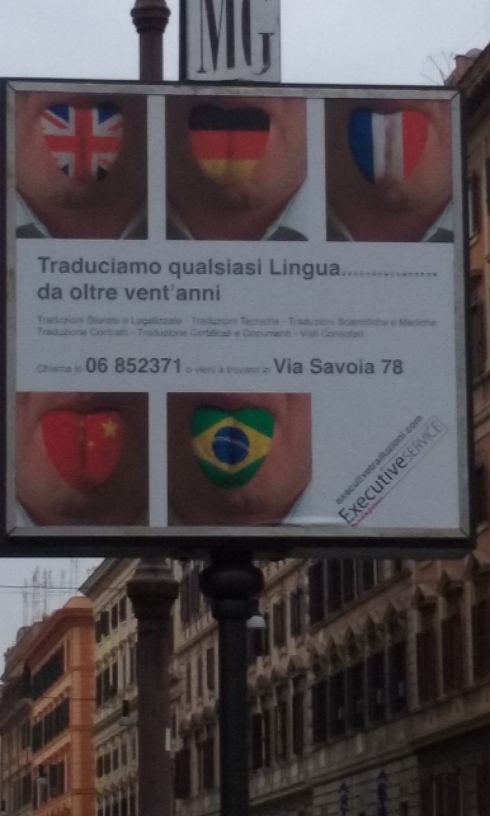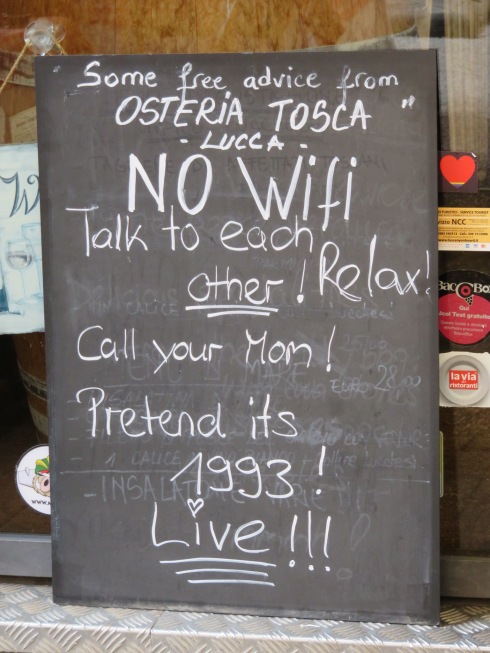Call it licking our wounds, making a silk purse out of a sow’s ear, or the silver lining to the storm cloud, we took refuge in a trip to the Cinque Terre in place of our long-planned-recently-aborted trip to the U.S.
In October of 2010, 2012, and 2013, we made sojourns to the Cinque Terre, but 2014 was to be the 2+ week trip to America to see friends and family, as well as attend our nephew’s wedding. We would skip the almost-annual fall hiking trip. Since we could not go to the U.S., and since the weather in October was not only holding steady in Rome but improving in the north, we found a last minute rental in Manarola and headed out last Wednesday, with promise of sun and moderate temps.

- Wind-whipped day on the Belvedere, Manarola, Cinque Terre, Italy.
We were not alone: the hoards have not let up their hold on the cute little villages. First clue was the mobbed train from La Spezia to Manarola on a Wednesday. The sea was rough so the boats that relieve train congestion did not run, making the train all the more fun. Luckily we had only an 11 minute train ride as we had to stand in the vestibule of the train as it chugged through the tunnels. In Manarola we found Andrea waiting as promised to lead us to our apartment. What providence for both of us! For Andrea to have a five night end-of-season rental, and for us to find such a great place that met or exceeded all of our criteria: Less than 100 Euro per night, WIFI, clothes washer, view of the sea, less than 50 stairs to climb, and a place to make coffee in the morning before the bars open. (I added the 50 stairs criteria after a couple of trips where we had 70 or 80 stairs to climb each time we came-and-went from our room or apartment and we decided we prefer spending our energy hiking or exploring a city, not in climbing to and from our lodging.) Andrea’s place is a large one bedroom with two matrimonial beds, and the possibility of renting two additional bedrooms one level down. Could be great for a large family.
People complain that the Cinque Terre is too crowded and touristy. It does seem these little villages are loved a bit too much by non-Italians. Interestingly, the majority of travelers here right now are French, German, Australian, and British. We have run into very few North Americans. While the five villages are cheek-by-jowl with tourists during the daytime, evenings are serene, restaurants can accommodate those of us staying the night, and we have once again found places to venture where few of those passing through bother to tread.
Instead of the famous Sentiero Azzuro between the towns, we headed up up up to Il Santuario di Nostra Signora di Reggio (The Sanctuary of Our Lady of Reggio). We saw one person at the top, and four on the way down. A far cry from the masses on the coastal trail. Click on any picture for a slide show.
-

-
Vineyards and olive groves dot the landscape.
-

-
How they built churches up here in the 13th century, I’ll never understand.
-

-
A lone hiker enjoys a picnic high above the Ligurian Sea at the sanctuary.
-

-
Ric as we ascend from sea level to the sanctuary at 317 m (1040 ft).
-

-
The Sanctuary of Our Lady of Reggio.
-

-
Punto di Ristoro at the Santuario. Honor system for drinks, snacks and even a fancy make-your-own espresso. Hey, it’s Italy!
We also headed to Portovenere, which has been on our list for the past three visits. The best way to Portovenere is by ferry, and when the wind is up they do not run. Friday there was a nationwide train strike from 09:00-17:00, so it seemed like a perfect day for a boat trip. We heard nothing but Italian and German in Portovenere. That is to say the tourists were European, not North American, for the most part. It is a fascinating little city with 2600 years of history. The Romans had huge influence, of course. There is a castle, a cemetery with a view, and the lovely Church of San Lorenzo, complete with fresco of his gruesome martyrdom. Returning to our little base in Manarola we could not believe how teaming it was with people after a peaceful day in Portvenere.
-

-
Approaching Portovenere from the sea. Imagine how formidable this fortress would look to invaders?
-

-
Portovenere from the dock. The colorful palazzi were part of the castle defense as well, a solid wall easy to defend.
-

-
View from high above Portovenere across the calm Gulf of the Poets, with the Appenine mountains in the background.
-

-
The little alley-like streets in Liguria are called “caruggi.” Here is one softened by a variety of plants.
-

-
Quiet commercial “caruggi” in Portovenere. No crowds here on a sunny October Friday!
-

-
View from a Gothic window in the “old” part of San Pietro Church, Portovenere.
-

-
Chiesa di San Lorenzo, Portovenere
-

-
The very old Chiesa di San Lorenzo in Portovenere.
-

-
The cemetery and mausoleum above Portovenere. Prime real estate.
Another bucket-list location for us in Liguria was Camogli. I wanted to do the hike from there to the Abbey at San Fruttuoso. Alas, it will remain on the bucket list as the weather report for the planned excursion day showed temps barely above freezing and light rain. We are not sure if the weather report we pulled up was wrong, but we dared not take the chance on a 75 minute one way train trip to find we could not hike. So we headed to La Spezia, which is “the big city” in these parts. Only 11 minutes from Manarola by train, it is of a decidedly different character, but has some redeemable charms. There is an excellent Naval Museum, a beautiful waterfront passeggiata, and a significant pedestrian shopping area no doubt designed to attract the cruise ship visitors that spend the day there. All-in-all we had a good city hike, logging almost 16,000 steps on the pedometer.
-

-
Lovely “passeggiata” along the waterfront at La Spezia.
-

-
Naval Museum at La Spezia with amazing models, ships figureheads, cannons, and Marconi’s (native son!) early equipment.
The special trail shoes and sticks are newly added to our gear, partially as a result of hiking this route two years ago. We had hikers on then, but not trail shoes made for this terrain. The shoes we had then tended to slip and made for some scary moments. The hiking sticks we have pooh-poohed in the past suddenly seemed like a good idea, and we adopted them as well as good trail shoes. We were very proud of ourselves for making this hike again and with proper gear. It was a hell of a workout, but we were safer for the gear. Once again, a lightly traveled route as so few people make their way to the higher trails.
-

-
My charming hiking partner. Note the hiking stick. Love them!
-

-
Hiking through vineyards high above the Ligurian Sea.
-

-
Ric wanted to show the condition of the trail in some spots. One wrong step….
-

-
Incredibly beautiful day to hike. How hot it would be in July!
-

-
High above the little town of Corniglia. Challenging descent ahead.
-

-
This is the rail for the “wine train” a little monorail system allowing the farmers to harvest grapes and drive through the steep terrain. I wish I could see one in action!
-

-
Every day started cool enough for a jacket, but by late morning we were down to t-shirts.
-

-
Boats in the street, Manarola. Love the boat parking, but then there are no cars.
-

-
The view from the Belvedere at Manarola, Monterosso al Mare in the distance.
Tags: Cinque Terre, Corniglia, Hiking, Italian language, Liguria, Manarola, Portovenere
 Your cane (pronounced KHAN-ay) may greet you at the door, but not allow you to lean on him for stability. One day on the bus we overheard an American couple remark “Look, cane parking!” when they saw a sign saying such and a little metal hook planted in the wall. It was, of course, a place to park your dog with a leash tie-up.
Your cane (pronounced KHAN-ay) may greet you at the door, but not allow you to lean on him for stability. One day on the bus we overheard an American couple remark “Look, cane parking!” when they saw a sign saying such and a little metal hook planted in the wall. It was, of course, a place to park your dog with a leash tie-up.








































